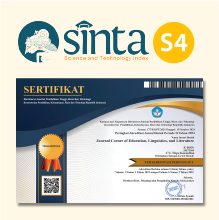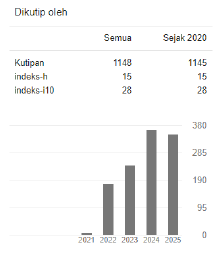The Value of Human Life in the Light of Suicide Tendencies among Students in Nigerian Tertiary Institutions: Implications for Education
 https://doi.org/10.54012/jcell.v2i1.49
https://doi.org/10.54012/jcell.v2i1.49
 Abstract views: 361
Abstract views: 361
 PDF downloads: 196
PDF downloads: 196
Keywords:
Education, Human Life, Implications, Nigeria, Students, SuicideAbstract
This paper examined the value of human life in the light of suicide tendencies among students in tertiary institutions in Nigeria. Being an act of taking or terminating one’s own life, suicide remains an enigma to all pro-life humans. In the distant past, cases of suicide were not so ubiquitous in Nigeria. Its occurrence was very rare; and where it happened, it was seen as an abomination of a high order, since life was considered sacred by the people, and which no human has the right to terminate. In those days of yore, suicide was alien to the people of Nigeria and their culture. Of recent, however, suicide has become a major leading cause of mortality among students in Nigerian tertiary institutions. Inherent difficulty in predicting and ascertaining its warning signs has made accurate and specific prediction of the occurrence of suicide most elusive. Over and above this, suicide is based on personal conviction of the individual that this is the best solution to his/her problem. On that note, the effort to prevent suicide should not focus more on predictions and signs, but on certain values and implications that would convince the individual (and the society) to jettison the idea of suicide as the best solution to a perceived problem. One of such values is human life, which has some implications for education. In this direction, the paper adopted a critical analysis of concepts and literature review to explore some risk factors for suicide, its implications for education and possible solutions to suicide tendencies amongst students, especially in the tertiary institutions in Nigeria. It was discovered that suicide tendencies among tertiary institution students in Nigeria is largely due to little knowledge of the value of human life and its implications. It was therefore recommended, among others, that premium emphasis be placed on the value of human life as sacred, both in the family and formal education settings
Downloads
References
Dwerk, (2018). “HIV-Positive Persons”. South African Journal of Psychiatry, 18(1):16–21.
Ekeh, G. (2019). “Nigerian Education and the Inculcation of Values: A Philosophical Appraisal”. Journal of Advances in Education and Philosophy, 3 (11), 414-419. Retrieved October 19, 2021. Doi: https://doi.org/10.36348/jaep. 2019.v03i11.005
Ekeh, G. (2020). “African Ontology as a Basis for African Existential Practices: Implications for African Education”. Journal of Education and Human Development, 9 (3), pp.88-92. DOI: https://doi.org/ 10.15640/jehd.v9n3a9.
Ekeh, G. (2007). Personalization of authentic values: A sure way to social integration and fulfilled living. Onitsha: Mid-Field Publishers Limited.
Ekeke, E. C., & Ikeagu, E. A. (2010). “The sanctity of human life in the twenty-first century: The challenge of euthanasia and assisted suicide”. Educational Research, 1 (9), pp. 312 – 318. http://www.interesjournals.org/ER.
Federal Republic of Nigeria. (2004). National policy on education. Lagos: NERDC Press.
Fergusson, O., & Woodwards, S. (2012). “Factors Associated with Depression among Adolescents living with HIV in Malawi”. BMC Psychiatry, 15(264):1–12. https://doi.org/10.1186/s12888-015-06499
Giri, S., Neupane, M., & Pant, S. (2017). “Quality of Life among People Living with Acquired Immune Deficiency Syndrome Receiving Anti-Retroviral Therapy: A Study from Nepal”. HIV/AIDS (Auckl), 5:277–82.
Humphrey, N. (2018). “The lure of death: Suicide and human evolution”. Philosophical Transactions of the Royal Society B. DOI: https://doi.org/10.1098/rstb.1027.0269
Kinyanda, et al. (2011). “Prevalence and Risk Factors of Major Depressive Disorder in HIV/AIDS as seen in Semi-Urban Entebbe District, Uganda”. BMC Psychiatry, 11(205). Doi: 10.1186/1471-244x-11-205.
Legg, T. J. (2019). “What is Suicide and Suicide Behaviour?” Retrieved May 17, 2021, from www.healthline.com/health/suicide-and -suicide-behaviour.
Masango, O. (2018). “Depression, Distress, Lymphocyte Subsets, and Human Immuno-Deficiency Virus Symptoms on two Occasions in H48IV-Positive Homosexual Men”. Arch Gen Psychiatry. 1991: 48:11–9.
Metz, T. (2013). Meaning in life: An analytic study. United Kingdom: Oxford University Press.
Musisi. S., & Kinyanda, E. (2017). “Emotional and Behavioural Disorders in HIV Positive Adolescents in Urban Uganda”. East African Med Journal, 86(1):16–24.
Nyorere, O. I., James, I. O., & Udom, I. E. (2020). “Personal Psycho Characteristics and Attitudes Towards Suicidal Behaviour among University Students in South Eastern States of Nigeria”. British Journal of Education, 8 (3), 16-26./10. DOI: https://doi.org/10.37745/bje/vol8.n03.pp16-26.2020.
Olufemi, A. (2019). “15 Nigerian Students Reportedly lost to Suicide Cases in 8 Months”. International Youth Journal. Retrieved October 5, 2021 from htps://youth-journal.org/15-nigerian-students-reportedly-lost-to-suicide-in-8-mcases.
Omigbodu, O., Dogra, N., Esan, O., & Adedokun, B. (2008). “Prevalence and correlates of suicidal behavior among students in Southwest Nigeria”. International Journal of Social Psychiatry, 54 (1), pp. 43 – 46.
Pompili, et al. (2013). “Epidemiology of Suicide in Bipolar Disorders: A Systematic Review of the Literature”. Bipolar Disorder, 15 (5), 457-90. Doi: 10.1111/bdi.12087.Epub 2013 June 12.
Prachi, J. (2015). “Learning: Definition, Characteristics and Types of Learning in Psychology”. Retrieved
October 13, 2021 from https://www.managementstudyguide.com/definition-characteristics-and-types-of-learning-in-psychology.htm
Psych Central Staff. (2018). “Psychosocial Issues of Children Infected with HIV/AIDS”. Indian Journal of Psychological Medicine, 35(1):19–22. https://doi.org/10.4103/0253-7176.112195
Resch, J. K. (2020). “What is the Meaning of Life?”. Available at www.alwaysAsking.com ˒ what-is-the-meaning-of-life/
Sandler, E. P. (2018). “The Ripple Effect of Suicide”. National Alliance on Mental Illness. https://www.nami.org.
Schneidman, E. S. (1985). Definition of suicide. New Jersey: Jason Aronson Incorporated.
Weaver, J. M. (2019). “Psychometric Properties of the 3-item Oslo Social Support Scale among Clinical Students of Bayero University, Kano”. MJP Online: Nigeria
World Health Organisation. (2019). “Suicide in the world: Global Health Estimates”. Retrieved October 18, 2021 from https://creativecommons.org/licenses/by-nc-sa/3.0/igo.
Downloads
Published
How to Cite
Issue
Section
License
Copyright (c) 2022 Greg Ekeh

This work is licensed under a Creative Commons Attribution-ShareAlike 4.0 International License.
All articles published in the Journal Corner of Education, Linguistics, and Literature are licensed under the Creative Commons Attribution-ShareAlike License (CC BY-SA).

















